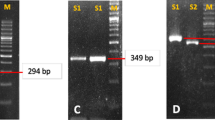Abstract
Helicobacter pylori appears to be a species with strain diversity, according to studies carried out using various molecular biological techniques. Differences in pathogenicity caused by the strain diversity ofH. pylori were therefore investigated. Two hundred and thirty strains were divided into four types by polymerase chain reaction-restriction fragment length polymorphism, and their relationship to endoscopic diagnosis, ammonia concentration of gastric juice, and urease activity were assessed. With regard to incidence by type, patients infected with type 1, type 2, and type 3 exhibited the highest incidences of gastric ulcer, duodenal ulcer, and gastritis, respectively. The urease activity of type 2 was significantly lower than that of types 1 and 3 (P<0.05). These observations suggest differences in pathogenicity due to the strain diversity ofH. pylori. However, the diversity of diseases related toH. pylori is also presumed to be caused by both the diversity ofH. pylori strains and differences in the host immunological reaction. Future studies should be directed toward clarifying the entire pathogenic mechanism ofH. pylori infection.
Similar content being viewed by others
References
Warren JR, Marshall B. Unidentified curved bacilli on gastric epithelium in active chronic gastritis. Lancet 1983;I:1273–1275.
Langenberg W, Rauws EAJ, Widjojokusumo A, et al. Indentification ofCampylobacter pyloridis isolates by restriction endonuclease DNA analysis. J Clin Microbiol 1986;24:414–417.
Majewski SIH, Goodwin CS. Restriction endonuclease analysis of the genome ofCampylobacter pylori with a rapid extraction method: Evidence for considerable genomic variation. J Infect Dis 1988;157:465–471.
Wyle FA, Chang KJ. Do strains ofHelicobacter pylori differ from one another? Eur J Gastroenterol Hepatol 1993;5(Suppl 1):S9-S15.
Labigne A, Cussac V, Courcoux P. Shuttle cloning and nucleotide sequences ofHelicobacter pylori genes responsible for urease activity. J Bacteriol 1991;173:1920–1931.
Hazell SL, Lee A.Campylobacter pyloridis, urease, hydrogen ion back diffusion, and gastric ulcers. Lancet 1986;II:15–17.
Queiroz DMM, Mendes EN, Rocha GA. Indicator medium for isolation ofCampylobacter pylori. J Clin Microbiol 1987;25:2378–2379.
Okuda H, Fujii S, Kawashima Y. A direct colorimetric determination of blood ammonia. Tokushima J Exp Med 1965; 12:11–23.
Lowry OH, Rosebrough NJ, Farr AL, et al. Protein measurement with the folin phenol reagent. J Biol Chem 1951;193:265–275.
Clayton CL, Kleanthous H, Coates PJ, et al. Sensitive detection ofHelicobacter pylori by using polymerase chain reaction. J Clin Microbiol 1992;30:192–200.
Akopyanz N, Bukanov NO, Westblom TU, et al. PCR-based RFLP analysis fo DNA sequence diversity in the gastric pathogenHelicobacter pylori. Nucleic Acids Res 1992;20:6221–6225.
Foxall PA, Hu L, Mobley HLT. Use of polymerase chain reation-amplifiedHelicobacter pylori urease structural genes for differentiation of isolates. J Clin Microbiol 1992;30:739–741.
Lopez CR, Owen RJ, Desai M. Differentiation between isolates ofHelicobacter pylori by PCR-RFLP analysis of urease A and B genes and comparison with ribosomal RNA gene patterns. FEMS Microbiol Lett 1993;110:37–44.
Tonokatsu Y, Hayashi T, Fukuda Y, et al. Heterogenecity of restriction fragment length polymorphism in the urease gene ofHelicobacter pylori. Eur J Gastroenterol Hepatol 1993;5(Suppl 1):S57-S62.
Clayton CL, Kleanthous H, Morgan DD, et al. Rapid finger-printing ofHelicobacter pylori by polymerase chain reaction and restriction fragment length polymorphism analysis. J Clin Microbiol 1993;31:1420–1425.
Fujomoto S, Marshall B, Blaser MJ. PCR-based restriction fragment length polymorphism typing ofHelicobacter pylori. J Clin Microbiol 1994;32:331–334.
Taylor DE, Eaton M, Chang N, et al. Construction of aHelicobacter pylori genome map and demonstration of diversity at the genome level. J Bacteriol 1992;174:6800–6806.
Tonokatsu Y, Hayashi T, Fukuda Y, et al. A clinico-epidemiological analysis ofHelicobacter pylori by Southern blotting with a urease gene probe. J Gastroenterol 1994;29:120–124.
Tonokatsu Y, Fukuda Y, Ymamamoto I, et al. Gastric ulcer andHelicobacter pylori: Diversity of urease gene (in Japanese). Mol Medicine 1994;31:1370–1374.
Vilardell F. Gastritis. In: Berk JE (ed) Bockus gastroenterology. 4th ed. Vol. 2. Philadelphia: WB Saunders, 1985;941–974.
Siurala M, Sipponen P, Kekki M.Campylobacter pylori in a sample of Finnish polulation: Relation to morphology and functions of the gastric mucosa. Gut 1988;29:909–915.
Ito S, Kohli Y, Kato T. Histology ofHelicobacter pylori (Hp) infection: Gastric local immunity to Hp (in Japanese). Nippon Rinsho (Jpn J Clin Med) 1993;51:3072–3075.
Kato C, Kano A, Sugawara M, et al. The relation between the urease activity ofHelicobacter pylori and gastritis (in Japanese with English abstract). Shokakika (Gastroenterology Tokyo) 1991;15:545–552.
Kim H, Park C, Jang WI, et al. The gastric juice urea and ammonia levels in patients withCampylobacter pylori. Am J Clin Pathol 1990;94:187–191.
Goodwin CS. Duodenal ulcer,Campylobacter pylori, and the “leaking roof” concept. Lancet 1988;II:1467–1469.
Dixon M. Acid, ulcers, andH. pylori. Lancet 1993;341:900–901.
Linfwood CA, Huesca M, Kuksis A. The glycerolipid receptor forHelicobacter pylori (and exoenzyme S) is phosphatidylethanolamine. Infect Immun 1992;60:2470–2474.
Blaser MJ. Hypotheses on the pathogenesis and natural history ofHelicobacter pylori-induced inflammation. Gastroenterology 1992;102:720–727.
Author information
Authors and Affiliations
Rights and permissions
About this article
Cite this article
Ito, A., Fujioka, T., Kubota, T. et al. Molecular typing ofHelicobacter pylori: Differences in pathogenicity among diverse strains. J Gastroenterol 31, 1–5 (1996). https://doi.org/10.1007/BF01211179
Received:
Accepted:
Issue Date:
DOI: https://doi.org/10.1007/BF01211179




